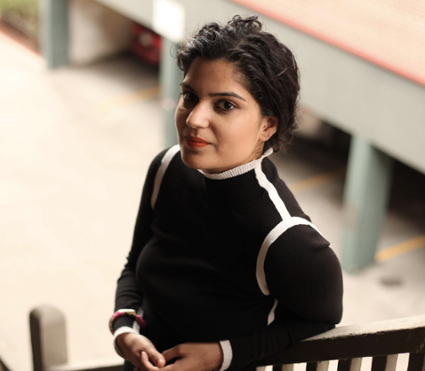Noor Bhangu
Noor Bhangu Shares how the Curatorial Practices Program Continues to Inform Her Scholarly and Curatorial Work
 The Faculty of Graduate Studies caught up with MA in Cultural Studies: Curatorial Practices alumna, Noor Bhangu, to hear about how her graduate experience has informed their academic and curatorial work post-graduation.
The Faculty of Graduate Studies caught up with MA in Cultural Studies: Curatorial Practices alumna, Noor Bhangu, to hear about how her graduate experience has informed their academic and curatorial work post-graduation.
Hi Noor, thanks for taking the time out of your busy day to share what you have been up to!
Can you tell us about your experience in the curatorial practices program? More specifically, what was your research focus?
I finished my Masters in Cultural Studies, the Curatorial Practices stream in 2017. Through the program, I took classes in cultural theories and curatorial practices, and was under the supervision of Dr. Julie Nagam. The interdisciplinary nature of the program alongside the very culturally-informed supervision by Dr. Nagam contributed to the success of the program for me. I was able to bring some concepts from broader cultural theory, such a close reading of diaspora through Stuart Hall and Paul Gilroy, into my curation of contemporary art.
For this program, I was also lucky to study with Pat Bovey in the Curatorial Practices Practicum, a full-year course for the CP stream students. Instead of matching me with art institutions in the city, she recognized my desire for critical research and encouraged me to research the question and relevance of Islamic art in the work of contemporary artists. I conducted studio visits with artists in the city and across Canada, which eventually developed into an exhibition, Lines of Difference: The Art of Translating Islam, which opened at La Maison des artistes visuels francophones in Winnipeg in 2019.
That's great that you were able to merge the concepts and practices from both streams.
What are you currently working on?
I am currently working on my PhD in Communication and Culture at York and Ryerson University in Toronto. My project is an extension of a curatorial class I developed with Dr. Serena Keshavjee for the Queen Elizabeth II Diamond Jubilee Scholarship, where I looked at the collection of Islamic art at the National Museum of Scotland. In my current work, I jump between historical collections of Islamic art, contemporary exhibitions, and research-based curatorial strategies.
Congratulations on being accepted into the Communication and Culture Doctorate program at York and Ryerson! You mentioned that your current project is an extension of your previous work in the curatorial program. On that note, how has your graduate experience informed your continued work in curatorial programming and other academic endeavors?
I think the most important skill I took away from my graduate experience is the ability to be discipline-fluid. Cultural Studies programs often encourage faculty and students to move and think across disciplinary lines, which I think is both an interesting and strong way to do research, academic and curatorial. My academic work enrols methods from Art History, History, and Critical Race Studies to do research that is academically vigorous but also has the potential to move into the world. Following this, my curatorial work is a really a form of public scholarship, a way for me to activate my research questions and content through the medium of a public exhibition or programming.
That must be rewarding, as an academic, to be discipline-fluid with the potential to move into the world. Can you share a rewarding experience where you were able to move your academic work into the world as a form of public scholarship?
There have been a few really rewarding and memorable experiences I can think of because I have been lucky enough to work with really great artists, writers, and institutions. But the most significant will have to be when a group exhibition I curated, Not the Camera, But the Filing Cabinet: Performative Body Archives in Contemporary Art opened at Gallery 1C03. The exhibiting artists, commissioned writers, and everybody was amazing to work with. For this exhibition, Jennifer Gibson created a space for me to geek for archival studies and artistic practices, while showing me the way to make this work accessible to the public through programming. Plus, it was incredibly moving to have professors, Dr. Roewan Crowe and Dr. Angela Failler, introduce the exhibitions and my work at the opening and closing receptions.
That does sound rewarding but also challenging at the same time. What advice would you share with other graduates of the Cultural Studies program who are considering pursuing curatorial work?
There is a lot to share from my own academic and curatorial work. But above all, I would advise graduate students to study the history of their field of interest, be it Cultural Studies, Islamic Art History, Indigenous Curatorial Practices, because it is important to know the landscape and its key characters before entering it.
Thanks for sharing that valuable piece of advice. What do you have planned for this year? Any projects?
This year, I will be preparing for and completing my comprehensive exams, which I will complete at the end of this summer or early fall. Beyond this, my focus will be divided between some programming, conferences, and research, including working for my MA supervisor, Dr. Julie Nagam, as the inaugural Artistic Director of Nuit Blanche Toronto.
Thank you and good luck with your studies at York and Ryerson!
Photo taken by Mariana Muñoz Gomez.
NewsCentre feature: Not the Camera, But the Filing Cabinet: Performative Body Archives
